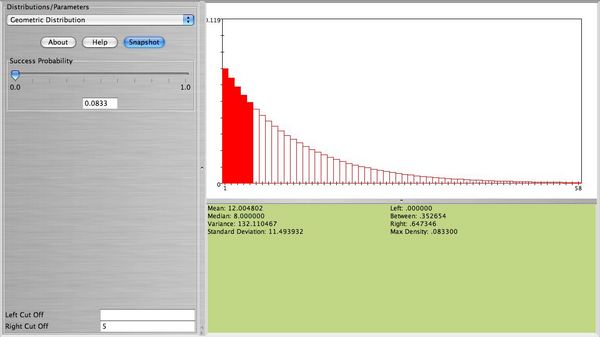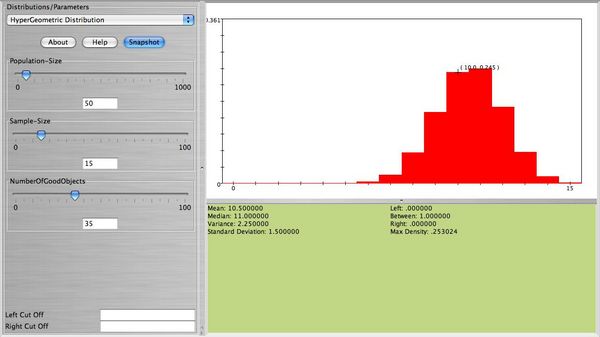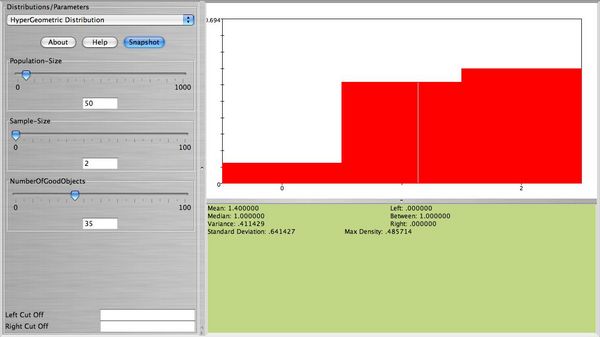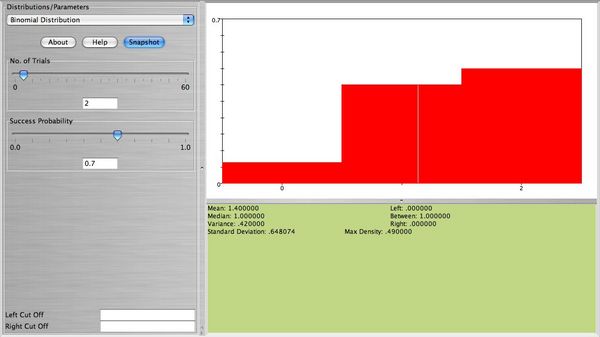SOCR EduMaterials Activities Explore Distributions
From Socr
(→This is an activity to explore the relations among some of the commonly used probability distributions.) |
(→This is an activity to explore the relations among some of the commonly used probability distributions.) |
||
| Line 12: | Line 12: | ||
<center>[[Image: SOCR_Activities_ExploreDistributions_Christou_figure2.jpg|600px]]</center> | <center>[[Image: SOCR_Activities_ExploreDistributions_Christou_figure2.jpg|600px]]</center> | ||
| - | Now, select without replacement only 2 marbles. | + | Now, select without replacement only 2 marbles. Compute the exact probability that 1 green marble is obtained. This is equal to |
| - | <math> P(X=1)=\frac{{35 \choose 1}{15 \choose 1}}{{50 \choose 2}}=0.4286 | + | <math> P(X=1)=\frac{{35 \choose 1}{15 \choose 1}}{{50 \choose 2}}=0.4286. </math> This is also shown on the figure below. |
| - | <center>[[Image: SOCR_Activities_ExploreDistributions_Christou_figure3.jpg|600px]]</center> | + | <center>[[Image: SOCR_Activities_ExploreDistributions_Christou_figure3.jpg|600px]]</center> |
| + | We will approximate the probability of obtaining 1 green marble using binomial as follows. Choose the SOCR binomial distribution and choose number of trials 2 and probablity of success <math> p=\frac{35}{50}=0.7 </math>. Compare the figure below with the figure above. The are almost the same! Why? Using the binomial formula we can compute the approximate probability of observing 1 green marble as <math> P(X=1)={2 \choose 1}0.70^10.30^1=0.432 </math> (very close to the exact probability). | ||
| + | |||
| + | <center>[[Image: SOCR_Activities_ExploreDistributions_Christou_figure4.jpg|600px]]</center> | ||
| Line 26: | Line 29: | ||
**d. <math> X \sim b(30,0.1) </math>, find <math> P(X > 2) </math>. | **d. <math> X \sim b(30,0.1) </math>, find <math> P(X > 2) </math>. | ||
| - | |||
| - | |||
| - | |||
| - | |||
| - | |||
| - | |||
| - | |||
| - | |||
| - | |||
| - | |||
| - | |||
| - | |||
| - | |||
| - | |||
| - | |||
| - | |||
| - | |||
| - | |||
| - | |||
| - | |||
| - | |||
| - | |||
| - | |||
| - | |||
| - | |||
| - | |||
| - | |||
| - | |||
| - | |||
| - | |||
| - | |||
| - | |||
| - | |||
| - | |||
| - | |||
| - | |||
| - | |||
| - | |||
| - | |||
| - | |||
Revision as of 00:32, 24 March 2007
This is an activity to explore the relations among some of the commonly used probability distributions.
- Description: You can access the applets for the above distributions at http://www.socr.ucla.edu/htmls/SOCR_Distributions.html .
- Geometric probability distribution: Let's roll two dice until a sum of 10 is obtained. What is the probability that the first sum of 10 will occur after the 5th trial? The answer to this question is
 . This is equivalent to the event that no sum of 10 is observed on the first 5 trials (5 failures). Now, using SOCR we can obtain this probability easily by entering in the SOCR geometric distribution applet
. This is equivalent to the event that no sum of 10 is observed on the first 5 trials (5 failures). Now, using SOCR we can obtain this probability easily by entering in the SOCR geometric distribution applet  and in the Right Cut-Off box 5. We can find the desire probability on the right corner of the applet. The figure below clearly displays this probability.
and in the Right Cut-Off box 5. We can find the desire probability on the right corner of the applet. The figure below clearly displays this probability.

- Binomial approximation to hypergeometric: An urn contains 50 marbles (35 green and 15 white). Fifteen marbles are selected without replacement. Find the probability that exactly 10 out of the 15 selected are green marbles. The answe to this question can be fund using the formula:
 Using SOCR simply enter population size 50, sample size 15, number of good objects 35, to get the figure below.
Using SOCR simply enter population size 50, sample size 15, number of good objects 35, to get the figure below.

Now, select without replacement only 2 marbles. Compute the exact probability that 1 green marble is obtained. This is equal to
 This is also shown on the figure below.
This is also shown on the figure below.

We will approximate the probability of obtaining 1 green marble using binomial as follows. Choose the SOCR binomial distribution and choose number of trials 2 and probablity of success  . Compare the figure below with the figure above. The are almost the same! Why? Using the binomial formula we can compute the approximate probability of observing 1 green marble as
. Compare the figure below with the figure above. The are almost the same! Why? Using the binomial formula we can compute the approximate probability of observing 1 green marble as  (very close to the exact probability).
(very close to the exact probability).

Use SOCR to graph and print the following distributions and answer the questions below. Also, comment on the shape of each one of these distributions:
- a.
 , find P(X = 3), E(X), sd(X), and verify them with the formulas discussed in class.
, find P(X = 3), E(X), sd(X), and verify them with the formulas discussed in class.
- b.
 , find
, find  .
.
- c.
 , find
, find  .
.
- d.
 , find P(X > 2).
, find P(X > 2).
- a.
- SOCR Home page: http://www.socr.ucla.edu
Translate this page:
